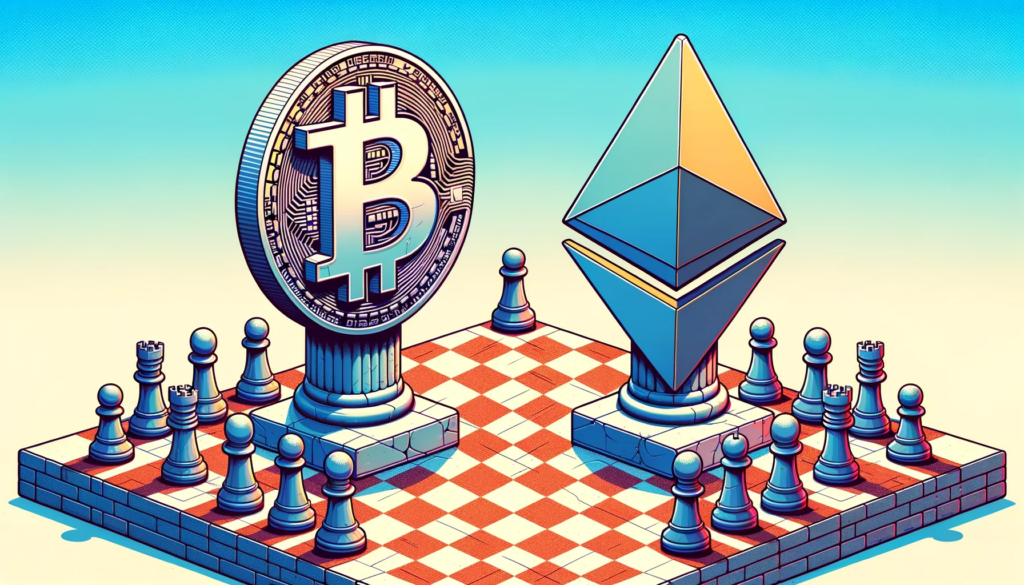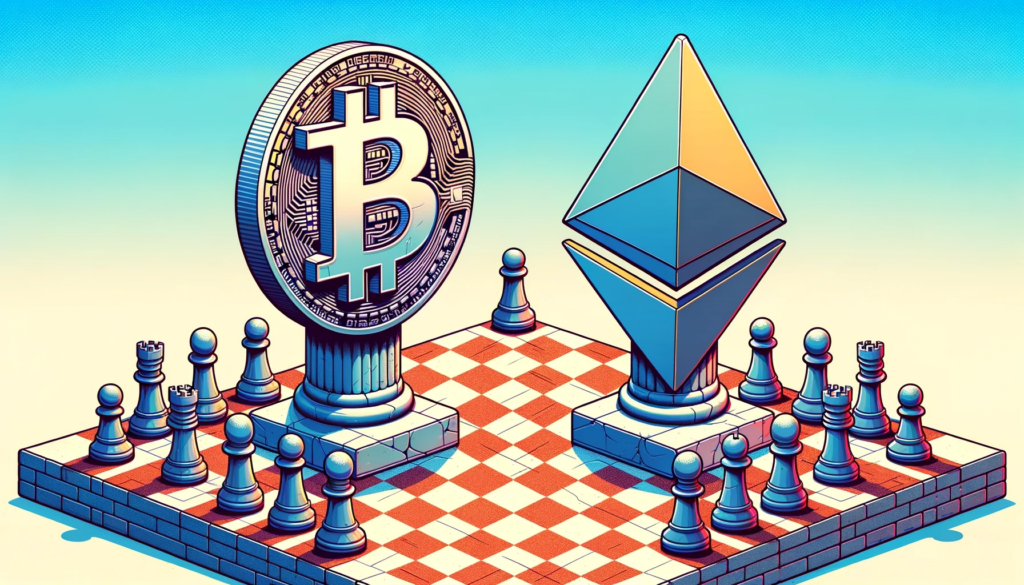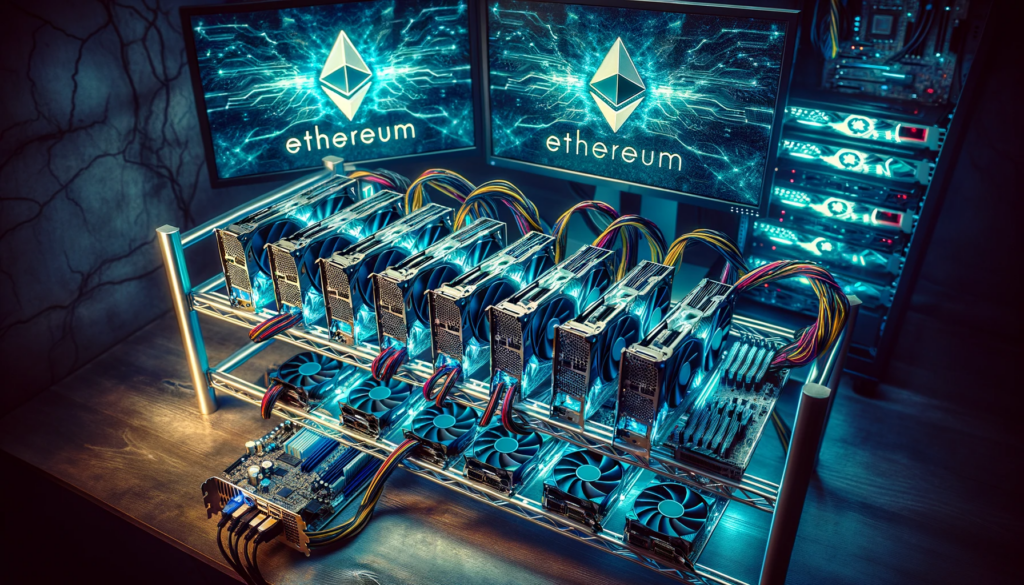Welcome to the captivating world of Ethereum, a groundbreaking platform that has revolutionized the blockchain ecosystem. Ethereum expands upon Bitcoin’s initial focus on peer-to-peer transactions and digital currency, providing a decentralized platform for developers to create smart contracts and build decentralized applications (DApps) that run autonomously without intermediaries. This innovative concept has opened doors to endless possibilities in various industries, from finance to gaming.
As the second-largest cryptocurrency by market capitalization, Ethereum, also used with the ticker ETH, has attracted a vibrant community of developers, researchers, and users passionate about creating a more decentralized future. In this comprehensive guide, we will explore the core components of Ethereum, including Ether, smart contracts, DApps, and the Ethereum Virtual Machine (EVM). We will dive into the inner workings of the Ethereum blockchain, as well as the flourishing world of DeFi and non-fungible tokens (NFTs) on the platform.
No matter your background, this guide is designed to help you understand Ethereum, its real-world applications, and the impact it can have on shaping our digital lives.
What is Ethereum?

Ethereum has emerged as a revolutionary force in the world of cryptocurrencies, driven by the vision of its creator, Vitalik Buterin. As the second-largest cryptocurrency, Ethereum has introduced smart contracts and decentralized applications (dApps) to the world, forever changing the landscape of digital finance. In this article, we delve into the fascinating origins of Ethereum and the significance of its native cryptocurrency, Ether.
The Ethereum ICO
To fund the development of Ethereum, a public crowdsale was held between July and August 2014. The Ethereum Initial Coin Offering (ICO) raised over 31,000 BTC, which was worth around $18.3 million at the time. This event marked the beginning of Ether’s journey as a tradable digital currency.
Ether: Beyond a Cryptocurrency
While Ether is often compared to Bitcoin, its primary purpose is not to act as a digital currency for peer-to-peer transactions. Instead, Ether is designed to facilitate the operation of the Ethereum network. As such, it holds immense potential for transforming industries and creating new possibilities for decentralized applications.
The Inspiration Behind Ethereum’s Name
Vitalik Buterin, the mastermind behind Ethereum, derived the name from the word “ether.” Ether refers to a hypothetical invisible medium that was once believed to permeate space and allow light to travel. In the context of Ethereum, the ether concept represents a decentralized platform for applications to run on, transcending traditional boundaries.
The Significance of the Name
By naming his platform Ethereum, Buterin wanted to evoke the idea of a fundamental, all-encompassing layer that could serve as the foundation for decentralized applications. The name Ethereum emphasizes the platform’s goal of becoming a global infrastructure for decentralized systems, just as the hypothetical ether was thought to enable the transmission of light across the universe. The name encapsulates the essence of Ethereum’s vision: to create a new world of decentralized applications and smart contracts, powered by the Ethereum blockchain.
The Genesis of Ethereum: Vitalik Buterin’s Vision
Early Life and Cryptocurrency Passion
Vitalik Buterin, the prodigious mind behind Ethereum, was born in Russia in 1994 before moving to Canada at a young age. His passion for mathematics and programming led him to the world of cryptocurrencies in 2011. Buterin began writing articles for the Bitcoin Magazine, and this involvement deepened his understanding of blockchain technology and its potential applications.
From Bitcoin to Ethereum
While Buterin recognized the potential of Bitcoin, he believed that blockchain technology could be further enhanced by adding more functionality. In November 2013, Buterin proposed a new platform called Ethereum, which aimed to create a decentralized, Turing-complete virtual machine capable of executing smart contracts and powering dApps.
The Ethereum Whitepaper
The Ethereum whitepaper was published in December 2013, detailing the technical framework for the Ethereum blockchain. This whitepaper outlined Ethereum’s objectives and the potential use cases for its platform, which extended far beyond the realm of digital currencies.
The Ethereum Foundation
With the support of fellow enthusiasts, including Gavin Wood, Joseph Lubin, and Charles Hoskinson, the Ethereum Foundation was established in early 2014. They quickly launched a successful crowdfunding campaign, raising over 31,000 BTC (worth approximately $18 million at the time). These funds fueled the development of Ethereum, leading to the release of its first version, “Frontier,” in July 2015.
The Ethereum Foundation is a non-profit organization dedicated to supporting the Ethereum ecosystem and its community. By providing essential resources, grants, and initiatives, the foundation aims to foster the growth of decentralized applications and the broader adoption of Ethereum technology.
The Ethereum Foundation upholds a set of core values and principles that guide its actions and decisions. These include:
- Integrity: The Ethereum Foundation is committed to maintaining the highest ethical standards in all its activities.
- Transparency: Open communication and access to information are essential to foster trust within the Ethereum community.
- Inclusivity: The foundation seeks to create an environment where everyone, regardless of their background, can contribute and benefit from the Ethereum ecosystem.
- Collaboration: The Ethereum Foundation actively collaborates with other projects, organizations, and individuals to drive innovation and adoption of Ethereum technology.
Ethereum vs. Bitcoin: Understanding the Key Differences

Purpose and Functionality
While Bitcoin was designed primarily as a digital currency, Ethereum was built as a versatile platform capable of executing smart contracts and supporting decentralized applications (dApps). This difference in purpose is reflected in their underlying technologies. However, Ethereum can also be used as digital money.
Smart Contracts and dApps
Ethereum’s most significant innovation is the introduction of smart contracts, self-executing agreements that run on the Ethereum Virtual Machine (EVM). These contracts enable a wide range of decentralized applications, from decentralized finance (DeFi) to digital identity management.
Consensus Mechanisms
Bitcoin uses a proof-of-work (PoW) consensus algorithm, while Ethereum has been transitioning from PoW to a more environmentally friendly proof-of-stake (PoS) consensus algorithm, called Ethereum 2.0.
Ethereum’s Role in the Blockchain Revolution

Decentralized Finance (DeFi)
Ethereum’s smart contract capabilities have fueled the rapid growth of DeFi, a movement aimed at democratizing access to financial services by removing intermediaries. DeFi platforms built on Ethereum allow users to lend, borrow, trade, and earn interest on their assets without relying on traditional financial institutions.
Non-Fungible Tokens (NFTs)
Ethereum has also played a crucial role in the rise of non-fungible tokens (NFTs), unique digital assets that represent ownership of a wide range of items, from art to virtual real estate. Ethereum’s ERC-721 and ERC-1155 token standards have become the backbone of the NFT market, enabling creators to mint, trade, and sell their unique digital assets.
Decentralized Autonomous Organizations (DAOs)
Ethereum has also given birth to decentralized autonomous organizations (DAOs), entities that operate through smart contracts and are governed by their stakeholders. DAOs have the potential to reshape industries and organizations by enabling more transparent, democratic decision-making processes.
Ethereum’s Development Milestones
Frontier: Ethereum’s First Release (2015)
On July 30, 2015, Ethereum officially launched its first release, known as Frontier. This initial version allowed developers to begin experimenting with dApps, smart contracts, and mining Ether. Frontier marked the beginning of Ethereum’s journey as a viable blockchain platform.
Homestead: Ethereum’s Second Release (2016)
Homestead, Ethereum’s second major release, went live on March 14, 2016. This version brought crucial improvements to the platform, including enhanced stability, performance, and security features. Homestead also introduced the Ethereum Improvement Proposal (EIP) process, a standardized method for proposing and discussing changes to the new protocol.
The DAO Hack and Ethereum’s Hard Fork (2016)
In June 2016, a decentralized autonomous organization (DAO) called The DAO, built on the Ethereum platform, was hacked, resulting in the theft of 3.6 million Ether. To recover the stolen funds and protect the platform’s integrity, the Ethereum community decided to implement a hard fork, splitting the blockchain into two separate chains: Ethereum (ETH) and Ethereum Classic (ETC).
Metropolis: Byzantium and Constantinople (2017-2019)
Metropolis, Ethereum’s new protocol and third major release, consisted of two parts: Byzantium (October 2017) and Constantinople (February 2019). These upgrades introduced significant improvements to the platform, including enhanced privacy features, reduced block times, and increased efficiency for dApp developers.
Istanbul and Muir Glacier (2019)
In December 2019, Ethereum underwent two additional upgrades: Istanbul and Muir Glacier. Istanbul introduced several EIPs that improved the platform’s security and interoperability, while Muir Glacier delayed the “difficulty bomb,” a mechanism designed to gradually increase the mining difficulty, incentivizing the transition to Ethereum 2.0.
Advantages of Ethereum

Smart Contracts
One of the key innovations of Ethereum is a decentralized contract solution, a concept of smart contracts. These are self-executing contracts that have the terms of the agreement directly written into the code. Smart contracts facilitate, verify, and enforce contract negotiations without the need for third parties, reducing transaction costs and increasing efficiency.
Decentralization
Ethereum is a decentralized network, which means that no single entity has control over the platform. This allows for increased trust and transparency, as all transactions are recorded on a public ledger that is accessible to everyone. Decentralization also reduces the risk of a single point of failure, as the network is distributed across multiple nodes.
Enhanced Security
The Ethereum blockchain is secured by a proof-of-work consensus algorithm, which requires miners to solve complex mathematical problems to validate transactions. This process called PoW helps maintain the integrity of the network and prevents malicious actors from tampering with the blockchain. As a result, Ethereum offers a high level of security for its users.
Ethereum Virtual Machine (EVM)
The Ethereum Virtual Machine (EVM) is a crucial component of the Ethereum ecosystem, as it enables the execution of smart contracts. The EVM is a Turing-complete virtual machine, which means it can execute any algorithm, given enough time and resources. This flexibility allows developers to create a wide variety of applications on the Ethereum platform.
Disadvantages of Ethereum
Despite Ethereum’s significant contributions to the world of DeFi and smart contracts, several Ethereum disadvantages cannot be ignored.
Scalability
One of the most significant challenges facing Ethereum is its limited scalability. The platform can currently process around 30 transactions per second (tps), which is not sufficient to support large-scale applications. This limitation has led to network congestion and increased transaction fees during periods of high demand.
Energy Consumption
Ethereum’s proof-of-work consensus algorithm requires a significant amount of computational power, resulting in high energy consumption. This has led to concerns about the environmental impact of Ethereum mining and has prompted the development of alternative consensus algorithms, such as proof-of-stake.
Regulatory Challenges
As with other cryptocurrencies, Ethereum faces regulatory challenges in various jurisdictions. Governments and regulatory bodies are still grappling with how to classify and regulate cryptocurrencies, and this uncertainty may have an impact on the adoption and future development of Ethereum. Additionally, some governments have implemented strict regulations on the use of cryptocurrencies, which may hinder the growth of the Ethereum ecosystem in certain regions.
Overall, these Ethereum disadvantages have driven some users to seek alternatives in the rapidly evolving world of blockchain technology.
Ethereum Forks: A Brief History
- Ethereum Launch (July 30, 2015): Introduction of the Ethereum blockchain, a decentralized platform for building smart contracts and decentralized applications.
- Frontier (July 30, 2015): The first live release of the Ethereum network, focused on allowing developers to mine Ether and create smart contracts.
- Homestead (March 14, 2016): The first major Ethereum upgrade, which introduced improvements to the network’s stability, security, and performance.
- Metropolis – Byzantium (October 16, 2017): The first part of the Metropolis upgrade, bringing privacy features, improved contract functionality, and increased scalability.
- Metropolis – Constantinople (February 28, 2019): The second part of the Metropolis upgrade, featuring efficiency improvements, reduced transaction costs, and more flexible upgradeability.
- Istanbul (December 8, 2019): A network upgrade that optimized gas costs, increased interoperability, and improved layer 2 scaling solutions.
- Muir Glacier (January 2, 2020): A quick update to delay the Ethereum “difficulty bomb,” ensuring a smoother transition to ETH 2.0.
- Berlin (April 15, 2021): An upgrade focused on gas optimization, increasing transaction efficiency, and enabling new transaction types.
- London (August 5, 2021): A significant upgrade that introduced EIP-1559, which overhauled Ethereum’s fee structure, improving the user experience and introducing a deflationary aspect to Ether.
- Shanghai (April 12, 2023): A major upgrade that introduced staking withdrawals to the execution layer, allowing stakers to withdraw their ETH from the Beacon Chain.
- Capella (April 12, 2023): The third major upgrade to the consensus layer, enabling staking withdrawals and providing automatic account sweeping functionality.
Ethereum’s Scalability and Future Developments
Layer 2 Solutions and Optimistic Rollups
Ethereum’s growing popularity has led to increased congestion on the blockchain network and higher Ethereum transaction fees. To address these challenges, developers have been working on Layer 2 solutions, which aim to increase the blockchain network’s scalability without compromising security. One such solution is optimistic rollups, a technology that bundles multiple Ethereuem transactions off-chain before settling them on the main Ethereum blockchain. This process significantly reduces transaction costs and increases throughput.
The Emergence of Interoperability
As the blockchain ecosystem continues to expand, interoperability between different platforms is becoming increasingly important. Ethereum has been at the forefront of this movement, with projects like Polkadot and Cosmos aiming to connect Ethereum with other blockchain networks. By enabling seamless communication between various blockchains, Ethereum is a decentralized leader, poised to play a central role in the growth and expansion of the decentralized web.
What are Ethereum’s Core Components?
Ether: The Cryptocurrency Powering Ethereum
Ether is the native cryptocurrency of the Ethereum network. It serves as the fuel for Ethereum transactions and the execution of smart contracts. As the lifeblood of Ethereum, Ether is essential for powering decentralized applications and maintaining the security of the platform.
How Ether is Created

Ether is created through a process called mining, in which miners solve complex mathematical problems to validate Ethereum transactions and add new blocks to the Ethereum blockchain. As a reward for their efforts, miners receive newly minted Ether. This process ensures the blockchain network remains secure and decentralized while providing a steady supply of Ether.
Ether’s Utility and Value
Ether has numerous use cases within the Ethereum ecosystem:
- Facilitating transactions: Ether is used to transfer value between two parties within the Ethereum network.
- Paying for transaction fees: Ether is required to pay for the computational resources needed to execute smart contracts and validate Ethereum transactions.
- Incentivizing mining: Miners are rewarded with Ether for their contributions to the blockchain network.
Ether’s value is derived from its utility within the Ethereum ecosystem, as well as its growing adoption and demand in the broader cryptocurrency market.
Ethereum Wallets
To manage and store Ether, users require an Ethereum wallet. An Ethereum wallet can be software-based or hardware-based and provide a user-friendly interface for managing Ether holdings and avoiding any security risk. Popular Ethereum wallets include MetaMask, MyEtherWallet, and Ledger.
A digital wallet can come in various forms, each with its own set of features and functionalities.
Hardware Wallets
Hardware wallets are physical devices that store your private keys offline. They provide the highest level of security, as they are immune to online threats and malware attacks. Popular hardware wallets include Ledger, Trezor, and KeepKey.
Software Wallets
Software wallets are applications that run on your computer or mobile device. They store your private keys and allow you to interact with the Ethereum network. Examples of software wallets are MetaMask, MyEtherWallet, and Exodus.
Paper Wallets
A paper wallet is a physical document that contains your private and public keys. It is a highly secure option for your digital money, as long as it is kept safe from physical damage or theft. To create a paper wallet, you can use a service like MyEtherWallet’s paper wallet generator.
Custodial Wallets
Custodial wallets are managed by third-party services, which hold your private keys on your behalf. These wallets offer user-friendly interfaces and additional services, such as exchanges or staking.
Smart Contracts: Revolutionizing Agreements on Ethereum
Smart contracts are self-executing contracts with the terms of the agreement directly written into code. They automatically execute when predetermined conditions are met, eliminating the need for intermediaries and increasing efficiency and trust.
The Anatomy of a Smart Contract
A smart contract is composed of the following elements:
- Contract address: A unique identifier for the contract on the Ethereum blockchain.
- Functions: Pieces of code that define the behavior and logic of the smart contract.
- State variables: Data stored within the smart contract that represents its current state.
- Events: Actions that can be triggered by the smart contract to notify external parties of specific occurrences.
The Role of Solidity: Ethereum’s Smart Contract Language
Solidity is a statically-typed, contract-oriented programming language specifically designed for developing smart contracts on the Ethereum platform. Its syntax is similar to JavaScript, making it accessible for developers familiar with web programming.
Deploying and Interacting with Smart Contracts
To deploy a smart contract, developers compile the Solidity code into bytecode and submit a transaction containing the bytecode to the Ethereum network. Once deployed, the contract is assigned a unique address, and users can interact with it by sending transactions to this address.
Decentralized Applications (DApps): Reimagining the Digital Landscape on Ethereum
DApps are applications built on top of the Ethereum blockchain, utilizing smart contracts to create decentralized, transparent, and tamper-proof services.
What Makes a DApp Unique
DApps have several distinct features:
- Decentralization: DApps rely on decentralized infrastructure, such as the Ethereum blockchain, for data storage and processing.
- Open-source: DApps have transparent and publicly auditable code, fostering trust and collaboration.
- Incentive mechanisms: DApps often incorporate token-based economies to reward users and encourage participation.
- Immutability: Ethereum transactions and data on DApps are permanently recorded on the public blockchain, making them resistant to censorship and tampering.
Creating and Deploying DApps on Ethereum
Developing a DApp on Ethereum involves writing smart contracts in Solidity, deploying them to the Ethereum network, and creating a user interface for interaction with the smart contracts. Tools like Truffle and Hardhat simplify the development and deployment process, while web3.js and ethers.js libraries enable seamless integration of Ethereum functionality into web applications.
What is Ethereum Virtual Machine (EVM): The Heart of the Ethereum Network
The EVM is a decentralized, Turing-complete virtual machine that executes smart contracts on the Ethereum network. It ensures that smart contracts run securely, consistently, and independently of the underlying hardware and software.
How the EVM Works
When a smart contract is deployed, the EVM translates the contract’s bytecode into native instructions that can be executed by the Ethereum network. Each instruction consumes a specific amount of computational resources, measured in units called gas.
The Role of Gas in Ethereum Virtual Machine Execution
Gas is the measure of computational effort required to execute operations within the Ethereum Virtual Machine. It serves three main purposes:
- Incentivizing miners: Miners are rewarded with Ether for executing smart contracts and validating Ethereum transactions, encouraging network participation.
- Ensuring resource allocation: Gas limits prevent infinite loops and excessive resource consumption, maintaining public blockchain network stability and performance.
- Aligning incentives: Users must pay for the computational resources they consume, discouraging spam and promoting efficient smart contract development.
The EVM’s Impact on Ethereum’s Scalability
The EVM’s design and reliance on gas for execution has implications for Ethereum’s scalability. As the public blockchain network grows, resource constraints can lead to network congestion and increased transaction fees. Ethereum’s developers are actively working on upgrades, such as Ethereum 2.0, to improve the platform’s scalability and performance.
Understanding the Ethereum Blockchain
Ethereum is a decentralized platform that enables developers to build and deploy smart contracts and decentralized applications (dApps) without the need for a central authority. The Ethereum blockchain is a distributed ledger that stores all transactions and smart contract executions in a secure, tamper-proof, and transparent manner. By utilizing a consensus algorithm, Ethereum maintains the integrity and security of its network while ensuring decentralization.
Transactions and Blocks: The Building Blocks of Ethereum
Transactions are the fundamental units of Ethereum’s network. They facilitate the transfer of ether (ETH), the platform’s native cryptocurrency, and the execution of smart contracts. Ethereum transactions are grouped into blocks, which are then linked together to form the blockchain. Each block contains a unique identifier called a hash, the previous block’s hash, and a timestamp, providing an immutable record of all transactions on the Ethereum network.
Types of Transactions on Ethereum
Ethereum supports three primary types of transactions:
- Ether transfer: Sending ether from one address to another.
- Smart contract deployment: Uploading a smart contract’s code to the Ethereum network.
- Smart contract execution: Interacting with a smart contract to execute its functions.
Each transaction type requires different amounts of computational resources, which determine the associated gas fees.
The Structure of an Ethereum Block
An Ethereum block consists of several components:
- Block header: Contains metadata, such as the block’s hash, the parent block’s hash, and a timestamp.
- List of transactions: Includes all transactions executed within the block.
- List of ommers: Includes the headers of uncle blocks, which are stale blocks that contribute to network security.
- State root: A hash representing the state of the Ethereum network, including account balances and smart contract storage.
- Receipts root: A hash representing the transaction receipts generated by the block’s transactions.
How Transactions are Processed on Ethereum
When users initiate transactions, they are broadcasted to the Ethereum network. Miners (in Proof of Work) or validators (in Proof of Stake) gather pending transactions and attempt to include them in the next block. The transaction processing includes:
- Validation: Ensuring that the transaction is correctly formatted and signed.
- Execution: Running the transaction code, such as transferring ether or invoking a smart contract function.
- State update: Updating the Ethereum network’s state to reflect the outcome of the transaction.
- Receipt generation: Creating a transaction receipt that summarizes the transaction’s effects.
Consensus Mechanism: How Ethereum Ensures Security and Decentralization
So how does Ethereum work? Ethereum relies on consensus mechanisms to agree on the state of the blockchain and maintain its security. The consensus ensures that all nodes have an identical copy of the blockchain, preventing double-spending and other malicious activities.
Proof of Work: Ethereum’s Initial Consensus Algorithm
Initially, Ethereum used the Proof of Work (PoW) consensus algorithm, where miners competed to solve complex cryptographic puzzles. The first miner to solve the puzzle could propose the next block and receive block rewards and transaction fees as incentives. However, PoW has drawbacks, including high energy consumption and potential centralization due to mining pools.
Proof of Stake: Ethereum’s Transition to a Greener Future
Ethereum 2.0 is an ongoing upgrade that introduces the Proof of Stake (PoS) consensus algorithm, known as the Beacon Chain. PoS relies on validators who lock up (stake) their ether to participate in block proposal and validation. Validators are selected randomly to propose and attest to blocks, receiving rewards for their participation. PoS reduces energy consumption and enhances network security and decentralization.
Validator Nodes and Staking Rewards
Becoming a validator in Ethereum’s Proof of Stake consensus requires staking a minimum of 32 ETH in the Beacon Chain. Validators are incentivized with rewards in the form of newly minted ether and transaction fees. The rewards are proportional to the amount of ether staked and the validators’ active participation in proposing and attesting to blocks. Penalties or slashing may occur if validators behave maliciously or fail to remain online consistently.
What is Ethereum Gas: The Cost of Processing Transactions on Ethereum
Gas is the unit used to measure the computational effort required to execute transactions and smart contracts on the Ethereum network. Gas ensures that users pay a fair price for the network resources they consume, while also preventing spam and malicious activities. Each operation within a transaction consumes a specific amount of gas, and the total gas consumed determines the transaction fee.
What is Ethereum Gas Price and Gas Limit
When users initiate a transaction, they specify two parameters:
- Gas price: The amount of ether a user is willing to pay for each unit of gas, typically denominated in gwei (1 gwei = 10^(-9) ETH).
- Gas limit: The maximum amount of gas the user is willing to spend on the transaction.
The transaction fee is calculated by multiplying the gas price by the gas consumed, up to the specified gas limit. If a transaction consumes more gas than the gas limit, it will fail, but the user will still be charged for the gas consumed.
What is Ethereum Gas Cost for a Transaction
Estimating gas costs for transactions can be challenging due to the dynamic nature of the Ethereum network and the fluctuating gas prices. However, users can use tools like Etherscan Gas Tracker and ETH Gas Station to monitor current gas prices and make informed decisions when setting a gas price and limits for their transactions.
How Gas Impacts Ethereum’s Scalability
High gas costs can negatively impact Ethereum’s scalability, as they may deter users from using the network and developers from building dApps. Additionally, periods of network congestion can lead to higher a gas price and slow transaction processing. Ethereum’s ongoing upgrade to Ethereum 2.0, along with Layer 2 scaling solutions like Optimistic Rollups and ZK-Rollups, aim to address these scalability challenges and lower gas costs.
The Evolution from Proof of Work (PoW) to Proof of Stake (PoS)
Ethereum, a leading blockchain platform, has been on a transformative journey, evolving from the traditional Proof of Work (PoW) consensus mechanism to Proof of Stake (PoS) that makes Ethereum a more efficient and environmentally friendly model to verify transactions.
Ethereum’s Proof of Work: The Genesis

Initially, Ethereum adopted the PoW consensus algorithm, similar to Bitcoin. PoW relies on miners who solve complex mathematical puzzles to allow network participants to verify transactions and add them to the blockchain. The miner who solves the puzzle first is rewarded with Ether, the native cryptocurrency of Ethereum. The process is highly competitive, requiring significant computational power and energy consumption.
Ethereum’s Proof of Stake: The Future
The PoS consensus mechanism is a more energy-efficient alternative to PoW. Instead of miners competing to solve puzzles, validators are chosen to create new blocks and validate transactions based on the amount of cryptocurrency they hold and are willing to “stake” as collateral. This eliminates the need for resource-intensive mining, resulting in a more environmentally friendly and scalable network.
Understanding Ethereum 2.0
Ethereum 2.0, also known as Eth2 or Serenity, is an ambitious multi-phase upgrade aimed at addressing the network’s scalability, security, and sustainability issues. The most notable change in ETH 2.0 is the shift from PoW to PoS, which will take place through the implementation of the Beacon Chain.
How does Ethereum work with the Beacon Chain? The Beacon Chain is a parallel PoS chain that runs alongside the current Ethereum PoW chain. Validators on the Beacon Chain will stake Ether and validate transactions, eventually leading to the merger of the PoW and PoS chains. This transition aims to enhance Ethereum’s scalability, security, and energy efficiency.
Environmental Impact of PoW and PoS
One of the main reasons for Ethereum’s transition from PoW to PoS is the environmental impact. PoW mining requires a vast amount of energy, contributing to increased carbon emissions. PoS, on the other hand, significantly reduces energy consumption by eliminating the need for resource-intensive mining operations. This shift makes Ethereum more environmentally friendly and sustainable in the long run.
Validator Responsibilities in PoS
In the PoS model, validators play a crucial role in maintaining the network’s security and integrity. Validators are responsible for:
- Proposing new blocks: Validators take turns proposing new blocks containing transactions to be added to the blockchain.
- Attesting to blocks: Validators attest to the validity of the proposed blocks, creating a consensus on the blockchain’s state.
- Staking Ether: Validators must stake a certain amount of Ether as collateral, ensuring their commitment to the network.
Validators who fulfill their responsibilities and contribute to the network’s security receive staking rewards in the form of newly minted Ether and transaction fees. Conversely, validators who act maliciously or fail to perform their duties may lose a portion of their staked Ether as a penalty.
Smart Contracts Unpacked
A New Paradigm for Digital Agreements
Ethereum smart contracts revolutionize the way digital agreements are created, managed, and executed. By automating enforcement and eliminating the need for trusted intermediaries, smart contracts provide a more efficient, transparent, and secure way to manage agreements in various industries and applications.
How Ethereum Smart Contracts Work
Ethereum smart contracts are self-executing, decentralized programs that run on the Ethereum blockchain. They automatically execute predefined conditions when specific criteria are met, ensuring that all parties adhere to the contract terms without the need for intermediaries. Smart contracts are written in the Solidity programming language, which is specifically designed for creating and managing contracts on the Ethereum platform.
Triggers and Execution
Smart contracts are triggered by events or transactions that are sent to the contract’s address on the Ethereum network. These triggers initiate the execution of the contract’s code, which automatically enforces the financial contract terms and updates the blockchain state. The result is an immutable, transparent record of the contract’s execution, providing a high level of trust and security for all parties involved.
Reading and Writing Data to the Blockchain
Ethereum smart contracts can read and write data to the blockchain, enabling them to interact with the decentralized database and store critical information. This interaction is facilitated by using contract storage variables and functions, allowing the contract to access, modify, and store data on the blockchain in a secure and transparent manner.
Integrating with External Data Sources
Ethereum smart contracts can also integrate with external data sources using oracles, which act as intermediaries that fetch off-chain data and provide it to the smart contract. This integration enables smart contracts to react to real-world events and conditions, increasing their utility and enabling a broader range of applications.
What is Ethereum Smart Contract – Use Cases and Real-World Examples
Ethereum smart contracts have the potential to revolutionize various industries and applications by offering a more efficient and secure way to manage agreements. Some notable use cases include finance and insurance, supply chain management, and identity management and authentication.
Finance and Insurance
Smart contracts can transform the financial and insurance industries by streamlining processes, reducing fraud, and automating claims settlements. For example, DeFi platforms leverage smart contracts to provide decentralized lending, borrowing, and trading services with greater transparency and lower fees than traditional finance by creating a distributed financial contract.
Supply Chain Management
Smart contracts can improve supply chain management by enhancing traceability, transparency, and accountability. By automating and tracking the movement of goods and payments, smart contracts can reduce delays, errors, and fraud in the supply chain process.
Identity Management and Authentication
Smart contracts can also play a crucial role in identity management and authentication by enabling the creation of decentralized identity solutions. These solutions can provide greater users control over their personal data and streamline the authentication process for online services.
Addressing Limitations and Security Concerns of Ethereum Smart Contracts
Despite their benefits, Ethereum smart contracts also face limitations and security concerns, such as potential vulnerabilities in the contract code and scalability issues. To address these challenges, developers must adhere to best practices for secure smart contract development and consider the role of formal verification in smart contract security.
Notable Smart Contract Hacks and Vulnerabilities
Several high-profile incidents have highlighted the risks associated with smart contract vulnerabilities, such as the DAO hack in 2016 and the Parity wallet vulnerability in 2017.
These incidents serve as important reminders of the need for rigorous security measures and best practices in smart contract development to prevent similar occurrences in the future.
Best Practices for Secure Smart Contract Development
To minimize security risks and vulnerabilities in Ethereum smart contracts, developers should adhere to the following best practices:
- Thoroughly test and audit smart contract code: Rigorous testing and auditing of smart contract code are crucial for identifying potential vulnerabilities and ensuring the contract behaves as expected.
- Use established patterns and libraries: Reusing well-tested and widely-adopted patterns and libraries can help reduce the likelihood of introducing errors and vulnerabilities in custom implementations.
- Implement access control and permissions: Implementing proper access control and permission structures within the smart contract can prevent unauthorized access and manipulation of the contract’s data and functions.
- Manage gas consumption efficiently: Developers should optimize smart contract code to minimize gas consumption, ensuring the contract remains cost-effective and preventing potential denial-of-service attacks due to excessive gas usage.
- Plan for upgradability and modularity: Designing smart contracts with upgradability and modularity in mind allows for easier updates and improvements, reducing the likelihood of encountering issues that require significant changes to the contract code.
The Role of Formal Verification in Smart Contract Security
Formal verification plays a vital role in smart contract security by mathematically proving the correctness of the contract’s code. This process involves creating a formal specification of the smart contract’s intended behavior and using automated tools to verify that the code meets this specification. Formal verification can help identify and address potential vulnerabilities in the smart contract code, increasing the trustworthiness and reliability of the contract.
Decentralized Finance (DeFi) on Ethereum
What is Ethereum DeFi?
Decentralized Finance (DeFi) is a revolutionary financial movement that utilizes the Ethereum blockchain to build financial applications and services that are transparent, permissionless, and accessible to all. By leveraging smart contracts, DeFi aims to disrupt the traditional finance sector by offering a wide range of innovative financial products, such as decentralized exchanges, lending and borrowing platforms, and stablecoins.
The Pillars of DeFi
Permissionless Access
DeFi enables users with an internet connection and a digital wallet to access a vast array of financial products and services, regardless of their location, wealth, or credit score. This democratization of finance breaks down barriers and empowers individuals and businesses worldwide.
Transparency and Openness
All transactions on the Ethereum blockchain network are publicly viewable and verifiable. This transparency fosters trust and accountability, allowing users to evaluate the safety and integrity of DeFi platforms and protocols.
Interoperability
DeFi protocols and applications are built on open standards, enabling seamless integration and collaboration. This interoperability fosters a vibrant ecosystem of financial services that work together to deliver innovative and powerful solutions.
Self-Custody
DeFi retains users control of their digital asset and private keys, eliminating the need for intermediaries and reducing counterparty risk. This self-custody model empowers individuals and businesses to manage their own financial affairs securely and independently.
Ethereum DeFi vs. Traditional Finance
DeFi offers a compelling alternative to traditional finance, characterized by the following differences:
- Decentralization: DeFi platforms operate on decentralized networks, eliminating the need for central authorities or intermediaries. This results in lower fees, faster transactions, and greater autonomy for users.
- Accessibility: DeFi is accessible to anyone with an internet connection, breaking down barriers to financial services and fostering economic inclusion.
- Transparency: Transactions on the Ethereum blockchain are publicly viewable, allowing users to verify the integrity of DeFi platforms and protocols.
- Innovation: DeFi’s open-source nature and interoperability facilitate rapid innovation, leading to the development of cutting-edge financial products and services.
DeFi’s Growth and Impact on Ethereum
Since its inception, DeFi has experienced explosive growth, with billions of dollars in total value locked (TVL) in various protocols. This growth has had a significant impact on the Ethereum network, driving demand for Ether (ETH) as collateral and increasing transaction volume. The popularity of DeFi has also accelerated the development of ETH 2.0, which aims to improve scalability, security, and energy efficiency.
Exploring Popular DeFi Projects and Platforms on Ethereum
Decentralized Exchanges (DEXs)
DEXs, such as Uniswap and SushiSwap, enable users to trade digital assets without relying on centralized exchanges. DEXs employ automated market makers (AMMs) and liquidity pools to facilitate peer-to-peer trading, reducing fees and increasing security.
Lending and Borrowing Platforms
Platforms like Aave, Compound, and MakerDAO provide decentralized lending and borrowing services. Users can supply a digital asset to earn interest, while borrowers can obtain loans using their digital assets as collateral. These platforms leverage smart contracts to automate the lending process, resulting in lower fees between two parties and increased accessibility.
Stablecoins and Synthetic Assets
Stablecoins, such as DAI and USDC, provide digital assets with low price volatility, making them ideal for transactions and a store of value. Synthetic assets, like those offered by Synthetix, enable users to gain exposure to traditional financial instruments, such as stocks and commodities, through the Ethereum blockchain.
The Future Development of Finance: Evaluating Opportunities and Risks on Ethereum
DeFi’s Potential to Disrupt Traditional Finance
DeFi has the potential to fundamentally transform the traditional financial landscape. By offering services such as lending, borrowing, and trading, DeFi platforms can empower individuals and businesses to access financial services without relying on intermediaries like banks and financial institutions.
Democratizing Access to Financial Services
DeFi platforms provide a more inclusive financial system by removing barriers to entry, such as credit scores and geographical limitations. By leveraging blockchain technology, DeFi platforms can offer a transparent, secure, and efficient way to access financial services, making them more accessible to a global audience.
Reducing Costs and Increasing Efficiency
Traditional financial institutions are often plagued by high operational costs and slow transaction processing times. DeFi platforms can significantly reduce these inefficiencies by automating processes through smart contracts and enabling peer-to-peer transactions, which can result in faster settlement times and lower fees.
Regulatory Challenges and Compliance
While DeFi holds immense potential, it also faces regulatory challenges and compliance issues. As the DeFi ecosystem continues to grow, governments and regulatory bodies are scrutinizing the sector to ensure consumer protection, financial stability, and adherence to anti-money laundering (AML) and know-your-customer (KYC) regulations.
Balancing Innovation and Regulation
Regulators need to strike a delicate balance between fostering innovation and protecting consumers. As DeFi platforms continue to evolve, it is crucial for regulators to stay informed and adopt a proactive approach to ensure that the sector remains compliant without stifling its growth.
Global Regulatory Coordination
Given the borderless nature of DeFi, global regulatory coordination is essential for creating a unified approach to compliance. Collaboration among regulatory bodies can help establish consistent rules and guidelines, paving the way for a more secure and compliant DeFi ecosystem.
Risks and Security Considerations in DeFi
As with any emerging technology, DeFi comes with its share of risks and security considerations. Users and developers need to be aware of the potential pitfalls to ensure a secure and seamless experience on DeFi platforms.
Smart Contract Vulnerabilities
Smart contracts are the foundation of DeFi platforms; however, they can also be susceptible to vulnerabilities and exploits. Developers must prioritize security audits and implement rigorous testing to minimize the risk of smart contract failures.
Liquidity and Market Risks
DeFi platforms often rely on liquidity pools to facilitate transactions. However, these pools can be vulnerable to market risks such as impermanent loss and sudden fluctuations in asset prices. Users should conduct thorough research and risk assessments before participating in liquidity pools.
Phishing and Scams
As DeFi gains popularity, bad actors may attempt to exploit users through phishing attacks and scams. It is crucial for users to be vigilant and verify the authenticity of platforms and services before engaging in transactions.
Non-Fungible Tokens (NFTs) on Ethereum
Demystifying NFTs: What are Non-Fungible Tokens on Ethereum?
Non-Fungible Tokens (NFTs) are unique, indivisible, and digitally scarce assets that exist on the Ethereum blockchain. Unlike cryptocurrencies such as Ether and Bitcoin, which are fungible and interchangeable, NFTs represent unique digital items with distinct attributes and ownership records. These tokens are increasingly being used for virtual art, collectibles, virtual real estate, and other creative applications.
The ERC-721 and ERC-1155 Token Standards
The Ethereum blockchain supports various token standards, with ERC-721 and ERC-1155 being the most popular for NFTs. These standards define the rules and interfaces that NFTs must adhere to, ensuring their compatibility with wallets, marketplaces, and other decentralized applications (dApps).
What is Ethereum ERC-721
ERC-721 is the first and most widely adopted standard for NFTs on Ethereum. It enables users with the creation of unique, non-fungible tokens with specific properties, metadata, and ownership records. ERC-721 tokens have individual smart contracts that govern their behavior, ensuring their uniqueness and non-interchangeability.
What is Ethereum ERC-1155
ERC-1155 is an advanced token standard that allows for the creation of both fungible and NFTs within a single contract. This standard optimizes the transfer and management of tokens, reducing the complexity and gas costs associated with handling multiple token types.
What is Ethereum NFT Metadata and Provenance?
Metadata and provenance are essential aspects of NFTs, as they provide information about the token’s properties, history, and ownership. Metadata is typically stored as a JSON file, which includes details such as the token’s name, description, image URL, and other attributes. This data is often hosted on decentralized storage platforms like IPFS to ensure its immutability and availability.
Provenance refers to the chain of custody and ownership history of an NFT. By leveraging the Ethereum blockchain, NFTs offer a transparent and tamper-proof record of ownership, enabling users to trace the origin and transfer history of a particular token.
The Value Proposition of NFTs
NFTs have gained significant attention due to their unique value proposition, which includes:
- Digital scarcity: NFTs enable the creation of scarce and limited-edition digital items, increasing their perceived value and collectibility.
- Ownership and transferability: NFTs provide a decentralized and secure method for proving ownership and transferring digital assets.
- Interoperability: NFT standards ensure compatibility with various dApps, wallets, and marketplaces, allowing users to trade and interact with NFTs across different platforms.
- Royalties and revenue sharing: NFTs can be programmed to include royalty and revenue-sharing mechanisms, enabling creators to earn a portion of proceeds from secondary sales.
The Ethereum NFT Ecosystem: Exploring Marketplaces and Platforms
The Ethereum NFT ecosystem is vast and growing, encompassing a wide range of marketplaces, creation tools, curation platforms, and novel use cases. Here, we’ll explore some popular options within these categories.
Popular NFT Marketplaces
- OpenSea: The largest NFT marketplace on Ethereum, offering a wide range of digital , collectibles, and other NFTs.
- Rarible: A user-friendly marketplace and platform for creating and trading NFTs, with a focus on digital art and collectibles.
- SuperRare: A curated marketplace for high-quality virtual art, featuring a selection of limited-edition pieces by renowned artists.
NFT Creation Tools and Platforms
- Mintable: A comprehensive platform for minting, managing, and selling NFTs.
- NFT Studio: A user-friendly platform for creating and minting NFTs, with customizable templates and easy-to-use design tools.
- Async Art: A platform specializing in programmable virtual art, enabling artists to create interactive, multi-layered NFTs with customizable elements.
NFT Curation and Discovery
- NFT Gateway: A platform for discovering and purchasing high-quality, limited-edition NFTs, featuring exclusive drops and partnerships with top brands and artists.
- KnownOrigin: A curated digital art platform that showcases and sells unique, authentic, and rare NFTs from a diverse array of artists.
- Foundation: A creator-first marketplace that connects artists and collectors, offering a curated selection of NFTs and enabling artists to mint and sell their work.
Uncovering Creative and Novel Use Cases for NFTs on Ethereum
NFTs on Ethereum have expanded beyond digital art and collectibles, finding their way into various industries and applications. Here are some notable use cases:
Digital Art and Collectibles
NFTs have revolutionized the digital art and collectibles space, enabling artists to create unique, scarce, and valuable digital assets. These tokens not only provide a means of proving ownership and provenance but also allow for royalties and revenue sharing, empowering creators in ways not previously possible.
Virtual Real Estate and Metaverses
NFTs are being used to represent virtual real estate within metaverse platforms such as Decentraland and Cryptovoxels. These tokens grant users ownership and control over virtual parcels of land and structures, enabling the development of virtual worlds, businesses, and experiences.
NFTs in Gaming and Esports
NFTs are increasingly being integrated into gaming and esports, representing in-game assets such as characters, items, and achievements. These tokens enable players to own, trade, and monetize their virtual assets, enhancing the gaming experience and fostering new economic models within the industry.
What is Ethereum 2.0: The Evolution of Ethereum

Ethereum, the world’s leading programmable blockchain, underwent a major transformation with the introduction of ETH 2.0. This upgrade aims to address the network’s key challenges, including scalability, security, and energy efficiency, while maintaining its core features and ecosystem support.
Key Features and Upgrades of Ethereum 2.0
ETH 2.0 is a complete overhaul of the current Ethereum blockchain, introducing several new features and upgrades to make the network more efficient, secure, and scalable. Some of the most significant changes include:
- Transition from Proof of Work (PoW) to Proof of Stake (PoS) consensus mechanism
- Implementation of shard chains for improved scalability
- Enhanced security measures and robustness against malicious attacks
- Energy-efficient consensus, reducing the environmental impact of the network
Scalability and Performance Enhancements
One of the primary goals of Ethereum 2.0 is to significantly improve the network’s scalability and performance. This is achieved through the introduction of shard chains, which allow for parallel transaction processing. Sharding divides the Ethereum network into smaller, interconnected chains, each capable of handling a portion of the total transactions. This enables ETH 2.0 to process thousands of transactions per second, compared to the current limit of around 30 transactions per second on Ethereum 1.0.
Enhanced Security Measures
ETH 2.0 introduces several security enhancements to protect the network from malicious actors and potential attacks. The shift from PoW to PoS consensus mechanism reduces the likelihood of 51% attacks, as it becomes much more expensive for an attacker to gain control of the majority of validator nodes and makes Ethereum more secure. Additionally, the introduction of shard chains also helps improve security, as malicious behavior on one shard is less likely to compromise the entire network.
Energy Efficiency and Environmental Impact
The transition from PoW to PoS consensus mechanism in Ethereum 2.0 leads to a significant reduction in energy consumption. PoS requires validators to stake their Ether (ETH) as collateral, rather than using computational power to mine blocks. This shift drastically reduces the energy consumption associated with mining, making Ethereum 2.0 more environmentally friendly and sustainable.
Ethereum 2.0 Phases and Roadmap
The rollout of Ethereum 2.0 is a complex, multi-phase process, involving several interconnected upgrades and future developments. The main phases of the Ethereum 2.0 roadmap include:
- Phase 0: The Beacon Chain
- Phase 1: Shard Chains
- Phase 1.5: The Merge
- Phase 2: Further Developments and Improvements
Phase 0: The Beacon Chain
The Beacon Chain, launched in December 2020, is the first step in the Ethereum 2.0 upgrade process. It serves as the backbone of the new PoS system, managing validators and their stakes. The Beacon Chain operates parallel to the existing Ethereum 1.0 blockchain, allowing the two networks to communicate and maintain compatibility.
Phase 1: Shard Chains
Phase 1 introduces shard chains, enabling the parallel processing of transactions for improved scalability. This phase is expected to bring 64 shard chains, each capable of processing a portion of the network’s transactions independently. Phase 1 also introduced cross-shard communication, allowing shards to interact and share information.
Phase 1.5: The Merge
The Merge marks a significant milestone in the Ethereum 2.0 upgrade process, as it involved the unification of the Ethereum 1.0 and Ethereum 2.0 networks. During this phase, the Ethereum 1.0 blockchain was merged with the Beacon Chain, effectively transitioning the entire network to the PoS consensus mechanism. This marks the end of traditional mining on the Ethereum network, as validators will now be responsible for securing the network and processing transactions.
Phase 2: Further Developments and Improvements
Phase 2 focuses on further enhancements and optimizations to the Ethereum 2.0 network, including the introduction of state execution engines and additional features to improve the overall user experience and lower gas fees. While the specifics of this phase are still being defined, it is expected to include improvements to cross-shard communication, smart financial contract execution, and data storage.
What Ethereum 2.0 Means for the Ethereum Ecosystem

The transition to Ethereum 2.0 brings significant implications for the entire Ethereum ecosystem, including developers, users, and miners.
Impact on Developers and Users
For developers and users, Ethereum 2.0’s improved scalability, security, and energy efficiency and lower gas fees will result in a more robust and versatile platform for building and deploying decentralized applications (dApps). Faster transaction processing, reduced gas fees, and greater network capacity will enable the development of more complex and resource-intensive dApps, enhancing the overall utility of the Ethereum ecosystem.
The Future of Ethereum Mining and Staking
With the transition from PoW to PoS consensus mechanism, Ethereum mining will eventually be phased out, replaced by a more energy-efficient staking process. This change will impact miners who have invested in mining hardware, as they will need to adapt to the new PoS system by becoming validators or finding alternative uses for their equipment.
Ethereum 2.0 also introduces a new staking model, where validators lock up their Ether as collateral to secure the network and earn rewards. This creates new opportunities for Ethereum holders to actively participate in the network’s security and earn passive income.
Ethereum 2.0’s Role in the Competitive Blockchain Landscape
Ethereum 2.0’s extensive upgrades will help maintain the platform’s position as a leading blockchain network in the face of increasing competition. By addressing the network’s scalability, security, and energy efficiency concerns, ETH 2.0 aims to provide a robust foundation for the future growth of DeFi and other innovative blockchain-based applications.
The successful implementation of ETH 2.0 will further cement the platform’s status as a frontrunner in the blockchain space, setting a high standard for other networks to follow.
What is Ethereum Classic?
Ethereum Classic (ETC) is an open-source, decentralized, and permissionless blockchain platform that runs smart contracts. It is the original Ethereum chain, developed as a response to a hard fork following the 2016 DAO hack. ETC aims to preserve the principles of immutability and censorship resistance, staying true to the original vision of the Ethereum platform.
The Birth of Ethereum Classic: A Historical Overview
In June 2016, a massive hack by an unknown hacker occurred on the Ethereum network, targeting a decentralized autonomous organization (DAO) built on the platform. This event led to the loss of around 3.6 million Ether (ETH) and triggered a split in the Ethereum community.
To recover the stolen funds from the unknown hacker and restore confidence in the platform, the Ethereum community decided to implement a hard fork. This created a new blockchain, with the original chain becoming ETC. The decision to fork was met with controversy, as some members believed it went against the principles of immutability and decentralization.
Understanding Ethereum Classic’s Decentralized Nature
Ethereum Classic is built on the principles of decentralization, immutability, and censorship resistance. It operates on a proof-of-work (PoW) consensus algorithm, similar to Bitcoin, ensuring that no single entity can control the network.
The PoW mechanism requires miners to solve complex mathematical problems to validate transactions and secure the network. In exchange for their efforts, miners receive ETC as a reward. This process ensures that power remains distributed among participants, preventing centralization and maintaining the integrity of the blockchain.
Ethereum Classic vs. Ethereum: Key Differences
While Ethereum Classic and Ethereum share a common history, there are several key differences between the two platforms:
- Consensus Mechanism: Ethereum Classic utilizes a PoW consensus algorithm, while Ethereum is transitioning to a proof-of-stake (PoS) mechanism with the Ethereum 2.0 upgrade.
- Development and Community Support: Ethereum has a more active development community and a larger user base, which has led to more frequent updates and a more extensive ecosystem of decentralized applications (dApps).
- Token Value and Market Capitalization: Ethereum (ETH) has a significantly higher market capitalization and token value compared to Ethereum Classic (ETC).
Investing in Ethereum

Analyzing Ethereum’s Market Performance: Trends and Insights
Ethereum’s market performance has been characterized by consistent growth since its inception in 2015. A key aspect of its success lies in its ability to foster innovation through the introduction of smart contracts and dApps. These features have attracted a significant number of developers and investors to the platform, driving the demand for Ether (ETH), Ethereum’s native cryptocurrency.
Ethereum’s Growth and Adoption
Since the launch of Ethereum 2.0 (ETH 2.0), the network has witnessed a surge in interest due to its transition to a Proof of Stake (PoS) consensus algorithm. This change aims to improve the scalability, security, and energy efficiency of the platform. Additionally, the growing popularity of DeFi has further fueled the demand for ETH, as the majority of DeFi projects are built on the Ethereum network.
Price History and Market Capitalization
Since the launch of ETH 2.0, the network has witnessed a surge in interest due to its transition to a Proof of Stake (PoS) consensus mechanism. This change aims to improve the scalability, security, and energy efficiency of the platform. Additionally, the growing popularity of DeFi has further fueled the demand for ETH, as the majority of DeFi projects are built on the Ethereum network.
Factors Influencing Ether’s Price:
Several factors have a direct impact on the price of Ether, including:
Network Upgrades and Developments
Ethereum’s ongoing upgrades and developments, such as the transition to ETH 2.0, directly affect its market performance. As the network evolves and improves, it attracts more users and developers, thereby increasing the demand for ETH.
DeFi and NFTs
The rapid growth of DeFi and the non-fungible token (NFT) market has significantly impacted Ethereum’s price. As the platform of choice for many DeFi and NFT projects, the demand for Ether increases with the growth of these sectors.
Ethereum’s Correlation with Other Cryptocurrencies
Ethereum’s price movement often correlates with that of Bitcoin and other major cryptocurrencies. This correlation is primarily due to market sentiment and investor behavior, as traders often treat cryptocurrencies as a single asset class.
However, Ethereum’s unique features, such as smart contracts and dApps, set it apart from other cryptocurrencies, allowing it to maintain a certain level of independence from market trends.
Risks and Considerations for Ethereum Investors
Market Volatility and Price Fluctuations
Like any other digital currency, Ethereum is subject to market volatility and price fluctuations. Investors should be prepared for the possibility of significant price swings and be ready to adapt their strategies accordingly.
Regulatory and Legal Risks
Regulatory and legal risks are a significant concern for cryptocurrency investors. As governments worldwide continue to develop frameworks for the regulation of digital assets, Ethereum investors should remain vigilant and informed about potential changes in legislation that may impact their investments.
The Impact of Emerging Blockchain Competitors
Ethereum faces competition from other blockchain platforms, such as Cardano, Polkadot, and Binance Smart Chain, which aim to offer improved scalability, security, and lower transaction fees. As these emerging competitors gain traction, Ethereum’s market dominance may be challenged, potentially impacting its price and overall market performance. Ethereum investors should keep an eye on these competitors and consider diversifying their investments to mitigate risks.
Ethereum’s Impact and Real-World Applications

The Power of Decentralization: How Ethereum is Shaping the World
Ethereum has revolutionized the way we think about decentralization, enabling a myriad of applications that were previously impossible or difficult to achieve. By leveraging the power of smart contracts, Ethereum has created a decentralized ecosystem that encourages collaboration, transparency, and innovation. This new paradigm shift has the potential to reshape industries, redefine governance, and create opportunities for economic growth and prosperity.
Decentralized Governance and Decision Making
Ethereum’s decentralized nature offers a powerful platform for governance and decision making. By utilizing smart contracts and decentralized applications (dApps), Ethereum can facilitate transparent and secure voting systems, enabling communities to make collective decisions without relying on a central authority. This fosters trust, reduces corruption, and empowers individuals to participate in the decision-making process, ultimately leading to more equitable outcomes.
Reducing Reliance on Centralized Institutions
Ethereum’s technology provides a viable alternative to traditional centralized institutions, allowing people to transact, store value, and access financial services without relying on intermediaries. By cutting out middlemen, Ethereum promotes financial inclusivity and reduces costs associated with transactions, paving the way for a more equitable and accessible financial system.
Fostering Innovation and Collaboration
Ethereum’s open-source nature encourages developers to build upon and improve the platform, fostering a global community of innovators working together to create new solutions. This collaborative environment has given rise to countless dApps and DeFi projects that are redefining industries and creating new opportunities for growth and development.
Industries Transformed by Ethereum: From Finance to Gaming
Finance and Decentralized Finance
Ethereum has had a profound impact on the financial industry, generally governed by a central authority, giving rise to a new era of DeFi. DeFi platforms leverage smart contracts to automate financial services like lending, borrowing, and trading, increasing efficiency and reducing costs. By offering decentralized alternatives to traditional financial services, Ethereum is democratiazing access to financial opportunities and fostering economic growth.
Gaming and Digital Collectibles
Ethereum’s ability to create digital assets has revolutionized the gaming industry. Through NFTs, developers can create unique digital collectibles that can be bought, sold, and traded on the Ethereum blockchain. This has opened up new revenue streams for game developers and allowed gamers to truly own and monetize their in-game assets.
Healthcare and Medical Records
Ethereum’s blockchain technology has the potential to revolutionize the healthcare industry by providing secure and transparent solutions for managing medical records. By storing medical data on a decentralized network, Ethereum can ensure patient privacy while improving the efficiency of to store data and data sharing among healthcare providers. This can lead to better patient outcomes and a more efficient healthcare system.
Intellectual Property and Content Creation
Ethereum’s technology can also be utilized to protect intellectual property rights and empower content creators. By leveraging NFTs and smart contracts, creators can establish ownership of their work, receive royalties, and control the distribution of their content. No central authority can stop the distribution of digital art. This fosters a more equitable ecosystem where artists are fairly compensated for their contributions.
Energy and Resource Management
Ethereum’s decentralized platform can help optimize energy and resource management by enabling transparent and efficient tracking of resources. Through the use of smart contracts and IoT devices, Ethereum can facilitate automated resource allocation, leading to a more sustainable and efficient use of resources.
Assessing Environmental and Social Implications of Ethereum’s Growth
As Ethereum continues to gain traction, it is essential to assess the environmental and social implications of its growth. While the platform offers numerous benefits, it also comes with challenges that need to be addressed to ensure sustainable and responsible development.
The Energy Consumption Debate
Ethereum’s energy consumption has been a topic of debate, as the Proof of Work (PoW) consensus mechanism requires significant computational power. This has led to concerns about the environmental impact of Ethereum mining, particularly in terms of carbon emissions and energy consumption.
Ethereum’s Transition to Proof of Stake
To address these concerns, Ethereum is transitioning to a more energy-efficient consensus mechanism called Proof of Stake (PoS). PoS significantly reduces the energy requirements for validating transactions and securing the network. The Ethereum 2.0 upgrade, also known as Eth2, is an ongoing effort to implement this transition, which will help reduce the platform’s environmental footprint while maintaining its security and decentralization.
Supporting Inclusivity and Equality through Decentralization
Ethereum’s decentralized nature can help promote inclusivity and equality by breaking down barriers to entry and providing opportunities for individuals worldwide. By empowering communities, fostering innovation, and promoting equitable distribution of resources, Ethereum can contribute to a more inclusive and equal world.
The Enterprise Ethereum Alliance (EEA)
The Enterprise Ethereum Alliance (EEA) was founded in 2017 with the aim of advancing the adoption of Ethereum-based technology in the corporate sector. It serves as a collaborative platform for businesses, researchers, and developers to develop, test, and implement Ethereum solutions tailored to the specific needs of enterprises.
The EEA has grown rapidly since its inception, with a diverse range of members from various industries such as finance, technology, healthcare, and supply chain. This extensive network has enabled the EEA to create innovative solutions and drive the widespread adoption of Ethereum’s blockchain technology in the corporate world.
Major Achievements of the EEA
The Enterprise Ethereum Alliance has made significant strides in realizing its mission of promoting Ethereum adoption in the corporate world. Some of the EEA’s notable achievements include:
- Publication of the Enterprise Ethereum Client Specification: This specification provides a comprehensive framework for developing enterprise-grade Ethereum clients, ensuring interoperability and compatibility across different implementations.
- Creation of the EEA TestNet: The EEA TestNet serves as a sandbox for members to develop, test, and deploy Ethereum applications in a secure, controlled environment.
- Formation of Industry-Specific Working Groups: The EEA has established numerous working groups that focus on specific industries or topics, enabling members to collaboratively develop use cases, best practices, and guidelines tailored to their respective sectors. Some of these working groups include the Financial Services Working Group, Supply Chain Working Group, and Healthcare Working Group.
- Hosting of Global Events and Conferences: The EEA has organized various events, webinars, and conferences to facilitate knowledge sharing, networking, and collaboration among its members, as well as to promote Ethereum technology to a wider audience.
The Future of Ethereum
Overcoming Challenges and Roadblocks for Ethereum’s Success
Ethereum has established itself as a leading platform for decentralized applications, but it faces numerous challenges that must be overcome to ensure its continued success. These challenges include scalability, interoperability, regulatory compliance, and competition from other blockchain platforms.
Scalability and Network Congestion
The Ethereum network has faced congestion issues due to its limited throughput. The introduction of ETH 2.0 and the transition to a Proof-of-Stake (PoS) consensus mechanism aims to improve scalability, reducing transaction times and lowering fees. Additionally, sharding will split the network into smaller, interconnected chains to handle more transactions simultaneously.
Interoperability with Other Blockchains and Systems
Interoperability is essential for connecting various blockchains and creating a seamless user experience. Ethereum platform developers are working on cross-chain solutions like Polkadot, Cosmos, and the Interledger Protocol to enable seamless interaction between different networks and facilitate the exchange of value and information.
Navigating the Regulatory Landscape
Regulatory compliance is crucial for Ethereum’s mainstream adoption. Ethereum must navigate the evolving regulatory landscape by working closely with regulators, ensuring transparency, and implementing robust security measures. This will help minimize risks and foster trust among users and investors.
Competing Blockchains and Technologies: How Ethereum Stands Out
Ethereum’s unique features, such as its Turing-complete programming language and thriving developer community, set it apart from competing blockchains. Its decentralized application ecosystem, coupled with the upcoming Ethereum 2.0 upgrade, positions it as a strong contender in the blockchain technology space. The Ethereum community is also the one of the largest and most active.
Comparing Ethereum to Other Smart Contract Platforms
Ethereum’s rivals, like Cardano, Polkadot, and Binance Smart Chain, offer alternative solutions for smart contract execution. However, Ethereum’s first-mover advantage, extensive developer community, and diverse ecosystem give it a competitive edge over these platforms.
The Role of Layer-2 Solutions and Sidechains
Layer-2 solutions and sidechains help address Ethereum’s scalability issues by offloading some transactions from the main chain. Examples include Optimistic Rollups, zkRollups, and Plasma. These technologies help reduce transaction costs and increase throughput, providing a better user experience.
Evaluating the Network Effect and Developer Adoption
Ethereum’s network effect is bolstered by its large Ethereum community and the numerous decentralized applications built on the platform. As more developers create and adopt Ethereum-based solutions, the network’s utility and value increase, further solidifying Ethereum’s dominant position.
Ethereum’s Vision for a Decentralized World: What’s Next?
Ethereum’s vision for a decentralized world is to enable trustless, permissionless interactions and foster innovation through DeFi, non-fungible tokens (NFTs), and decentralized autonomous organizations (DAOs). The platform’s continued development and upgrades will propel it toward this goal, moving away from a central authority.
The Internet of Value and Web 3.0
Web 3.0, or the Internet of Value, envisions a decentralized and democratized digital landscape. Ethereum’s smart contract functionality and interoperability with other blockchains can help create this new paradigm, empowering users and driving innovation.
Emerging Use Cases and Technological Advancements
As Ethereum evolves, new use cases and technological advancements will emerge. These may include decentralized identity management, tokenized assets, supply chain tracking, and voting systems. These innovations will further cement Ethereum’s position as a leading blockchain technology platform.
Why Invest in Ethereum?
Ethereum is the second-largest cryptocurrency by market capitalization and has gained significant attention from investors and developers alike. Its unique ability to host decentralized applications and facilitate smart contracts has made it an attractive investment option for many. Key benefits of investing in Ethereum include:
- Innovation and development: Ethereum’s vibrant developer community continually pushes the boundaries of blockchain technology, resulting in new and exciting applications.
- Smart contract functionality: The Ethereum network allows for the creation and execution of smart contracts, which can automate complex transactions without intermediaries.
- Decentralized finance (DeFi): Ethereum has become the backbone of the rapidly growing DeFi ecosystem, offering various financial services without traditional intermediaries.
- Wide acceptance: As one of the most well-known cryptocurrencies, Ethereum is widely accepted by merchants and service providers globally.
Choosing the Right Platform to Buy Ethereum

Buying Ethereum is a crucial step for anyone interested in investing in the world of cryptocurrencies, decentralized applications, and decentralized finance.
There are numerous platforms where you can buy Ethereum using a bank account, debit card or credit card, or investment account with low security risk. This includes cryptocurrency exchanges, peer-to-peer (P2P) platforms, and brokerage services. When selecting the right platform for your needs, consider the following factors:
- Fees: Compare transaction fees across different platforms to ensure you’re getting the best deal from the cryptocurrency exchange.
- Security: Look for platforms with a strong security record and robust security features such as two-factor authentication (2FA) for your exchange account.
- User experience: Choose a platform with an intuitive interface and responsive customer support.
- Payment methods: Ensure that the platform accepts your preferred payment method, such as credit card, debit card, bank account transfers, or other cryptocurrencies.
- Regulation and compliance: Select a platform that complies with regulatory requirements in your jurisdiction to avoid potential legal issues.
How to Buy Ethereum with Fiat Currency
Purchasing Ethereum with FIAT currency, such as USD, EUR, or GBP, is a straightforward process. Follow these steps to buy Ethereum using your local currency:
- Select a platform: Choose a reputable platform or investment account that supports conventional currency transactions, such as a cryptocurrency exchange or a brokerage service to buy Ether.
- Create an account: Sign up for an account on the platform by providing your email address and setting a secure password. You may also be required to complete a Know Your Customer (KYC) process, which involves verifying your identity.
- Link your payment method: Connect your preferred payment method to your account. This can include credit/debit cards, bank transfers, or e-wallets, depending on the platform.
- Deposit fiat currency: Transfer your desired amount of national currency from your bank account to your account on the platform. Be sure to check for any deposit fees or minimum deposit amounts.
- Place an order: Navigate to the platform’s trading interface and place a buy order for Ethereum to buy Ether. You can choose between a market order, which buys ETH at the current market price, or a limit order, which buys ETH at a specified price.
How to Buying Ethereum with Other Cryptocurrencies
If you already own cryptocurrency like Bitcoin (BTC) or Litecoin (LTC), you can easily exchange them for Ethereum. Follow these steps to buy Ethereum using other cryptocurrencies:
- Select a platform: Choose a cryptocurrency exchange that supports trading pairs between your own cryptocurrency and Ethereum.
- Create an account: Sign up for an account on the platform and complete any necessary verification processes to buy Ether.
- Deposit your cryptocurrency: Transfer your existing cryptocurrency to the platform’s designated wallet address. Ensure you’re using the correct wallet address to avoid losing your funds. Make sure you you do not share any sensitive information such as a private key in the process.
- Place an order: Navigate to the platform’s trading interface and place an order to exchange your cryptocurrency for Ethereum. Similar to buying with fiat currency, you can choose between market orders and limit orders.
Conclusion
In conclusion, Ethereum has emerged as a groundbreaking blockchain platform, enabling the development of decentralized applications and smart contracts. Ether, as its native cryptocurrency, plays an integral role in the ecosystem by facilitating transactions and incentivizing miners. With its innovative technology and ambitious plans for future development, Ethereum has the potential to revolutionize industries and redefine our understanding of digital assets.
We would like to extend our sincere gratitude to you for taking the time to read this article. We hope that it has provided you with valuable insights into the world of Ethereum and Ether, and has deepened your understanding of this remarkable technology. As the blockchain and cryptocurrency landscapes continue to evolve, we encourage you to stay informed and engaged in this fascinating field. Thank you once again for joining us on this educational journey.

